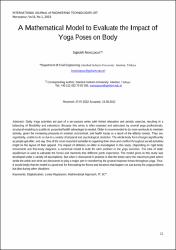| dc.contributor.author | Norozpour, Sajedeh | |
| dc.date.accessioned | 2024-01-18T22:29:39Z | |
| dc.date.available | 2024-01-18T22:29:39Z | |
| dc.date.issued | 2023 | en_US |
| dc.identifier.issn | 2149-0104 | |
| dc.identifier.issn | 2149-5262 | |
| dc.identifier.uri | https://hdl.handle.net/11363/6973 | |
| dc.description.abstract | Daily Yoga activities are part of a ten-posture series with linked relaxation and aerobic exercise, resulting in a
balancing of flexibility and extensions. Because this series is often repeated and advocated by several yoga professionals,
structural modeling to justify its purported health advantages is needed. Older is recommended to do more workouts to maintain
activity, given the increasing pressures in societal, economical, and health issues as a result of the elderly society. They are,
regrettably, unable to do so due to a variety of physical and psychological obstacles. The whole body form changes significantly
as people get older, and sag. One of the most important variables in regaining their drive and comfort throughout social activities
might be the layout of their apparel. The impact of athletics on older is investigated in this study. Depending on rigid body
movements and free-body diagrams, a numerical model is built for each position in the yoga exercises. The idea of static
equilibrium is used to calculate the forces and moments that different joints experience. The model given in this study was
developed under a variety of assumptions. But what is discovered in practice is that the knees carry the maximum joint action
while the ankle and wrist are discovered to play a major part in transferring the ground response forces throughout yoga. Thus,
it would imply that the model is a good tool for forecasting the forces and durations that happen not just during the yoga positions
but also during other situations. | en_US |
| dc.language.iso | eng | en_US |
| dc.publisher | İstanbul Gelişim Üniversitesi / Istanbul Gelisim University | en_US |
| dc.relation.isversionof | https://doi.org/10.19072/ijet.1149555 | en_US |
| dc.rights | info:eu-repo/semantics/openAccess | en_US |
| dc.subject | Digitalization | en_US |
| dc.subject | Linear Regression | en_US |
| dc.subject | Mathematical Approach | en_US |
| dc.subject | IT | en_US |
| dc.subject | ICT | en_US |
| dc.title | A Mathematical Model to Evaluate the Impact of Yoga Poses on Body | en_US |
| dc.type | article | en_US |
| dc.relation.ispartof | International Journal of Engineering Technologies | en_US |
| dc.department | İstanbul Gelişim Üniversitesi | en_US |
| dc.authorid | https://orcid.org/0000-0003-3542-1932 | en_US |
| dc.identifier.volume | 8 | en_US |
| dc.identifier.issue | 1 | en_US |
| dc.identifier.startpage | 21 | en_US |
| dc.identifier.endpage | 24 | en_US |
| dc.relation.publicationcategory | Makale - Ulusal Hakemli Dergi - Kurum Öğretim Elemanı | en_US |
| dc.contributor.institutionauthor | Norozpour, Sajedeh | |

















